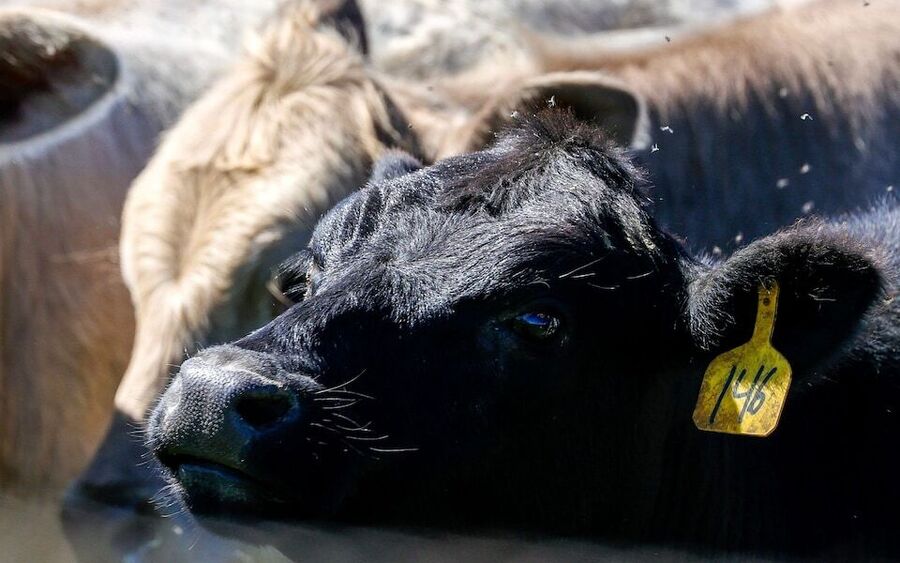
© ADAM DAVIS/EPA-EFE/ShutterstockFILE: Experts say the US is not sharing as much data on the outbreak as it should.
To date, the US Department of Agriculture has tallied 32 affected herds in eight states: Idaho, Kansas, Michigan, New Mexico, North Carolina, Ohio, South Dakota, and Texas. In some cases, the movement of cattle between herds can explain the spread of the virus. But the USDA has not publicly clarified if all the herds are linked in a single outbreak chain or if there is evidence that the virus has spilled over to cows multiple times. Early infections in Texas were linked to dead wild birds (pigeons, blackbirds, and grackles) found on dairy farms. But the USDA reportedly indicated to Stat News that the infections do not appear to be all linked to the Texas cases.
Comment: It doesn't seem as though this 'link' was proven to the be culprit, because there were other more likely routes of transmission - just 2 weeks ago it was reported: Ground-up chicken waste and excreta fed to cattle may be behind bird flu outbreak in US cows
Spread of the virus via cattle movements indicates that there is cow-to-cow transmission occurring, the USDA said. But it's unclear how the virus is spreading between cows. Given that even the most symptomatic cows show few respiratory symptoms, the USDA speculates that the most likely way it is spreading is via contaminated milking equipment.
Adding to the uncertainty of the virus's spread, The New York Times on Friday reported that the one herd found infected with H5N1 in North Carolina showed no symptoms of the virus.
Comment: One recalls the fearmongering over asymptomatic covid cases.
This raises the possibility that the virus could be silently spreading in unknown numbers of other asymptomatic herds and states. In its most recent FAQ document, the USDA encouraged testing for H5N1 if herds show clinical symptoms, such as lethargy, fever, low milk production, and loose stools. But the Times noted that the agency has begun reimbursing farms for testing asymptomatic cows.
Comment: So farmers are being paid to test otherwise seemingly healthy cows? Note that bird flu has been found in everything from humans to arctic seals; and does the presence of a virus mean anything significant? Typical, healthy human viromes have been found to contain everything from HIV to herpes, and to no ill effect.
Meanwhile, the USDA also reported that it has evidence that H5N1 from dairy farms has spread back into birds in nearby poultry farms, but how this is happening is also unknown.
Comment: A rather dubious claim.
Data gaps
All the uncertainty and widespread transmission raises concern about how the virus is evolving to infect mammals and whether it is heading for humans. Last week, the chief scientist for the World Health Organization, Jeremy Farrar, told reporters in Geneva that the spread of the virus in US dairy cows is an "enormous concern," according to CNN. "The great concern, of course, is that in doing so and infecting ducks and chickens — but now increasingly mammals — that that virus now evolves and develops the ability to infect humans. And then critically, the ability to go from human-to-human transmission."
Comment: We know that humans have already been infected, and died, it's just relatively rare; albeit seemingly on the increase:
In particular, experts are wary that the dairy cow outbreaks could spill over to nearby pig farms as it's doing with nearby poultry farms. Pigs can be infected with both bird flu viruses and human flu viruses, making them potential melting pots for new recombinant flu strains.
So far, the USDA says that genetic sequences of H5N1 viruses infecting cows has not revealed any mutations that "would make it more transmissible to humans and between people."
Comment: Not yet: US $100 million research to make bird flu strains MORE infectious & deadly
But last Thursday, Stat reported that international experts have faulted the USDA for not sharing more genetic data from its investigation, among other information. Until this weekend, the agency had only shared a few genetic sequences in an international database of viral genome sequences (GISAID).
"A country with capacity like the United States should be able to generate this information within days," Marion Koopmans, head of the department of viroscience at Erasmus Medical Center in the Dutch city of Rotterdam told Stat last week. "I would expect very fast, very transparent updates, and it's somewhat amazing not to see that happening."
Comment: China shared the covid sequence within weeks.
On Sunday, facing mounting criticism, the USDA announced the release of 239 genetic sequences to GISAID. It noted it is also adding raw data to a US federal database "in the interest of public transparency and ensuring the scientific community has access to this information as quickly as possible." The agency said it will continue to make such data available on a rolling basis.
Dr. Rosemary Sifford, the USDA's chief veterinarian, told the Times, "Please recall that we've been engaged in this for less than a month. We are working very hard to generate more information," she said.
Overall, the USDA and the US Centers for Disease Control and Prevention continue to consider the risk to the public to be low. Farmworkers and others who have direct contact with infected animals are encouraged to take precautions, however.
While deadly to birds, H5N1 in cows is relatively mild, rarely if ever causing deaths. Milk from sick animals contains high levels of virus, but it is being destroyed. Even if some infected milk makes its way into the milk supply, the Food and Drug Administration is confident that the virus would be killed in the pasteurization process. "Pasteurization has continually proven to inactivate bacteria and viruses, like influenza, in milk," the agency said in an FAQ Friday. Some experts have called for data confirming this, though.
Source link

